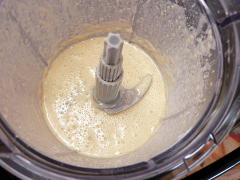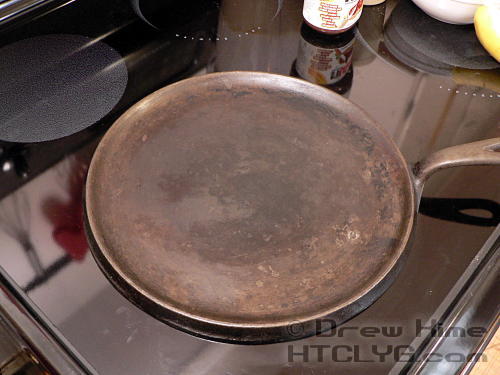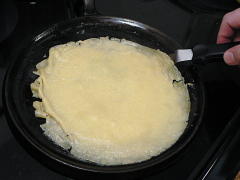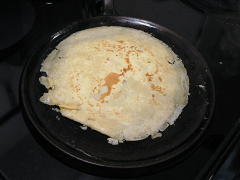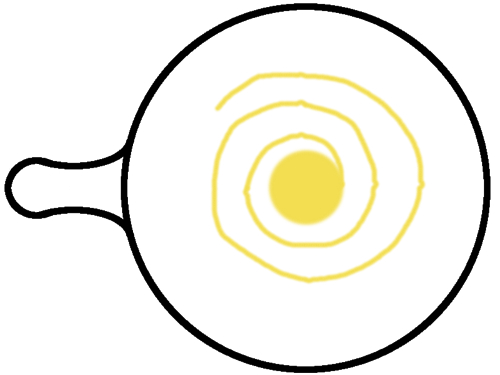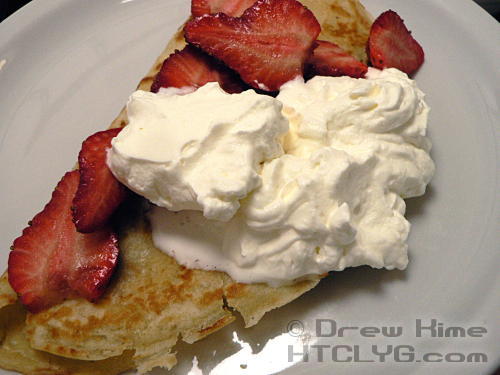Crêpes are one of the simplest pastries you can make quickly for breakfast. Four ingredients (plus water) that you can put together in any order and be ready to cook in about 2 minutes. And half that is melting the butter. You’d think they’d show up on the menu more often, except that the technique can be a little tricky.
No, that’s not right. It’s not the technique so much as the hardware. You need a really good pan to cook them in: heavy bottom (cast iron is best), non-stick (well-seasoned cast iron), flat bottom and shallow sides. Some people are as protective of their crêpe pans as they are of their omelet pans[1] — meaning you’ll lose a hand if you try to use it for anything else. Once you’ve had good ones, you’ll believe it’s worth it.
This recipe is shamelessly stolen from Alton Brown, but the technique is slightly different. I’m sure his technique works fine with plenty of practice, but I haven’t had plenty of practice. And if I do enough practice to get really good at it, none of my pants will fit.
Ingredients
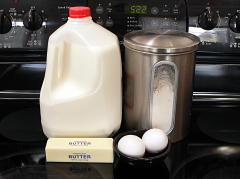 2 large eggs
2 large eggs
¾ cup milk
½ cup water
1 cup flour
3 tablespoons melted butter
butter, for coating the pan
Directions
The batter
Combine the eggs, milk, water (mine looks cloudy because I used the same measuring cup from the milk), melted butter and flour in a blender or food processor. (Or a Ninja.)
Pulse 10 times so the batter is completely smooth but no more.
If you beat it too much the flour will start to get gummy.
The hardware
Here’s the pan I was talking about.
It doesn’t look very pretty, but that surface is smooth as glass. I haven’t seen this shape anywhere else, so unfortunately I can’t tell you where to find one new. Andrew has a relatively close example over at CloveGarden. (It’s listed as “Cast Iron Round Griddle / Comal / Tava”.)
Let the pan warm up over medium-low heat until it’s just warm enough that it’s uncomfortable to touch with your hand. Add a half-tablespoon of butter and, when it’s melted, brush it around the pan with a pastry brush or BBQ sauce brush.
The classic technique
For this first one, I used the technique you usually see demonstrated. I poured the batter into the middle of the pan, then picked it up and tilted the pan around to distribute the batter.
You can see that the edges are too thin, and the center is already setting up. I tried pushing the edges in a little with a spatula …
… which sort of worked. It didn’t look real pretty, but I was able to turn it over without losing any major pieces.
That first turn should come when you start seeing bubbles in the batter, about a minute. Slip a long, skinny spatula underneath and flip it over.
Here’s a look at the spatula I’m talking about.
That’s a cake decorating spatula, designed for spreading frosting on the top layer.
The alternate technique
Once the pan is up to temperature, each crêpe is done in just a minute or two. Which is my excuse for not having pictures of the second technique I tried. (That and the fact that I didn’t know it was going to work until I tried it.)
Instead of pouring all the batter into the center, pour a small amount in the center then start spiraling out away from the center.
Do it just right and you’ll end up with an evenly-thin layer of batter from edge to edge in your pan. Which I’d love to show you but, like I said, things got a little hectic.
The other alternate technique — don’t try this at home
Restaurants and specialty shops where they make a lot of crêpes have a special electric skillet called a billig, which is much larger than any pan you’re likely to have in your kitchen. Onto this the cook will pour the batter, then spread it out with a rozel, a T-shaped wooden tool made just for doing omelets.
Click here for a nice set of photos showing how to make crêpes with the bilig and rozel.
To serve
You could stop here and serve the crêpes like pancakes. Or fill each one with fruit, the way you’d fill an omelet with vegetables.
Or do what I did: Fill with sliced bananas and top with strawberries and whipped cream.
And that’s it.
[1] Before there was Julia, there was Dione Lucas, the first woman to graduate the Cordon Bleu. She brought the omelet to the U.S., and opened a restaurant specializing in them, The Egg Basket. She once said:
All these omelets I make in my special pan, which has not been used for anything else in the sixteen years I have owned it. Neither has it ever been washed, for water would cause the omelets to stick to the pan.

Ingredients
- 2 large eggs
- ¾ cup milk
- ½ cup water
- 1 cup flour
- 3 tablespoons melted butter
- butter, for coating the pan
Instructions
Combine the eggs, milk, water, flour and melted butter in a blender or food processor. Pulse 10 times, but don't over-mix or the flour will get gummy.
Heat a shallow pan over medium-low heat just until it is too hot to touch with your bare hand, then melt a half-tablespoon of butter on it.
Pour out just enough batter to thinly coat the pan all the way around. Cook until it starts to bubble, then turn it over with a long, thin spatula.
Cook on the other side until lightly browned. Serve with berries and whipped cream; or savory, with chicken or turkey, feta cheese and fresh spinach.






